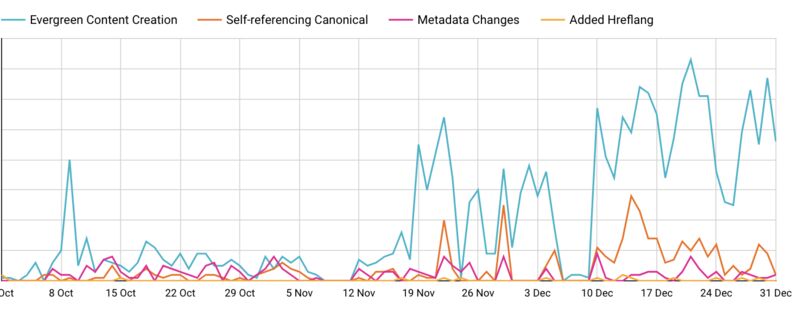A/B testing for Google’s bots or users is quite difficult. Mainly because it could be considered cloaking if you’re not doing it right + SEO is one of the slowest channels dependant on things like your crawlability.
One of the things you can do is something that I mentioned in a recent article for The Drum is:
“Isolate each activity for reporting so you see how they impact each other. Proving ROI in the long run will relieve internal tension on activity and easily create case studies.”
An easy way to do this is in Google Data Studio by creating a custom field that segments URLs by activity.
The custom field formula looks something like this for a Google Analytics connector:
CASE
WHEN REGEXP_MATCH(Landing Page,'/product/thing') then "Added Hreflang"
WHEN REGEXP_MATCH(Landing Page,'/about/') then "Self-referencing Canonical"
WHEN REGEXP_CONTAINS(Landing Page,'/blog/') then "Evergreen Content Creation"
WHEN REGEXP_CONTAINS(Landing Page,'/Services/') then "Metadata Changes"
ELSE "Other"
ENDFlip between REGEXP_CONTAINS or REGEXP_MATCH depending on the array of pages that activity was commenced on. Add a | between each page path for more than 1 URL per test.
You’ll need a thorough experiment ideology before you start. Key for testing is well is to only isolate URLs when no other influence has happened on the page. So if it is metadata changes make sure it’s only that which happened to that page.
Here’s some other approaches on how to test pages for SEO:
- Rachel Costello – A/B & Multivariate Testing for SEO: How to Do It the Right Way
- Nick Swan – The Complete Guide to SEO Testing
- Joshua Hardwick – SEO Testing: A Simple (But Complete) Guide
- Jeff Reynolds –The Right Way to Do SEO Split Testing
If you have any other ways you do SEO testing feel free to comment.
